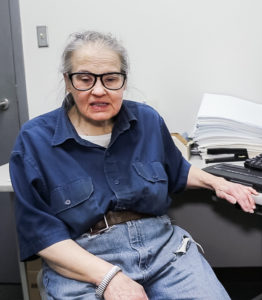Mary Helen Scheiber
Four Decades and Still Counting
By Linda Norlen

Mary Helen Scheiber started working at the Lighthouse as a temporary college student employee in the summer of 1973. She returned to the Lighthouse in 1974 and has worked here ever since.
Originally from Boise, Idaho, Mary Helen was born with damaged optic nerves in both eyes. She struggled in elementary school until she learned braille and was fortunate to have her mother learn braille and transcribe materials for her. During her junior year of high school, Mary Helen’s family relocated to Pullman, Washington for her father’s work at Washington State University. After graduating from Pullman High School in 1970, she attended college at WSU for almost three years before leaving to join the Lighthouse.
Mary Helen’s first job at the Lighthouse was in the sewing room, ironing military neckties. Her next job involved folding safety vests and signal flags, and learning the cutting tables. There were tactile indexes used to line up the materials to cut the correct length of the parts. She had to keep up with the fast sewers, who also served as inspectors of her work.
Mary Helen says the jobs in the sewing room gave her the money to rent an apartment and take on the regular responsibilities of living on her own, just like her sighted family members. “There are transferable skills from work tasks that can be used in independent living tasks,” she says. “For example, if I can take a bus to and from work, I can take a bus to the store, get my groceries, bring the food back home, and cook the food by myself.”
Over the years, Mary Helen has worked in virtually all the departments of the Lighthouse factory. From the mop and broom shop, where she learned a variety of machine and packaging skills, to the machine shop, where she made Boeing aerospace products. Mary Helen then went on to fabricating the GSA Ability One military products. Besides learning machining and assembling skills herself, Mary Helen was also able to teach these skills to her coworkers.
For the past 12 years, Mary Helen has worked as a Braille Production Specialist. She uses computer software and hardware to translate documents (including pay stubs) into braille for her braille-reading coworkers. By creating braille documents, Mary Helen enables her fellow colleagues to fully participate in job tasks, classes, and meetings. She welcomes any chance to help her coworkers improve their skills and advance within the company.
In her four decades at the Lighthouse, Mary Helen has observed many changes – a huge increase in the number of different types of products produced, an increase in the diversity of languages spoken by workers from all around the world, a growing DeafBlind program, braille production and training, and continually expanding opportunities through assistive technology training and accessibility in the workplace.
Mary Helen remembers many colleagues who empowered her by either their work ethic or their training of her, but she especially appreciated Dorothy and Bob Mitchell. In the 1970s, they organized social activities for blind employees on Friday evenings and invited new employees to participate in meals out or going bowling.
Mary Helen has learned from many different employees as she has moved to various departments of the company. Among others, Bob Mitchell taught her how to deburr parts correctly. Don Helsel taught her how to run milling machines, while Shirley Kinnison taught her how to safely run drill presses and saws and to correctly make parts on those machines. A mentor to all was Arnie Nermore, who taught workers in Assembly to assemble parts and run drill presses. He was also willing to discuss blindness techniques, whether at work or on the bus with a group of workers on the way to and from work. Jerry Kopp gave Mary Helen the chance to teach blindness skills and job tasks to other employees who were blind, because he liked her skill running machine processes and wanted her to empower other employees. After switching departments again, Mary Helen sought help from Kirk Adams, former President and CEO, and Don Swaney when she became a Braille Production Specialist and first started making braille documents.
One feature of the Lighthouse that Mary Helen has enjoyed for many years is the Ethel L. Dupar’s Fragrant Garden, a site for many outdoor lunches. Mary Helen recollects the day that the Fragrant Garden was established during her first summer working at the Lighthouse in 1973. After the ribbon-cutting ceremony, Mary Helen and her co-worker LaNae Munsel were invited by Rudy Elmer, former Lighthouse President to tour the garden with a local television crew. The cameras were able to capture how the blind interacted with the garden based on their other senses and used braille signage to learn more about each plant. The footage aired on local television later that night, and for that day, Mary Helen and LaNae were “Lighthouse TV stars.”
When asked about the overall impact the years of working at the Lighthouse has had on her, Mary Helen says, “My steady employment at the Lighthouse has provided the money needed to become a homeowner, a taxpayer, and a productive citizen of the local community like any other person. I am one of the small percentage of the blind who are employed and plan to stay working at the Lighthouse for many more years.”